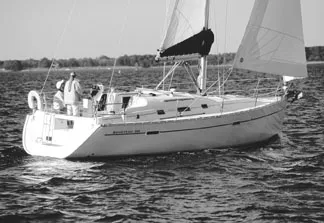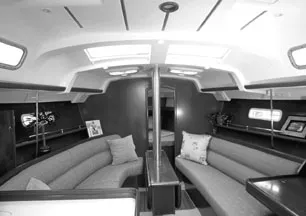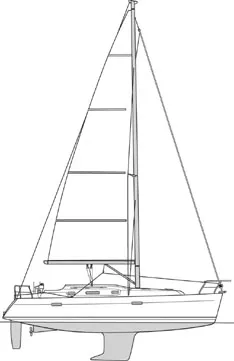Chantiers Beneteau has been building its distinctive sailboats (along with Jeanneau, Wauquiez, and, now, a line of trawlers) for so long that it seemingly offers boats sized in 12-inch increments. As a result, the company is introducing the third makeover of existing boats, in some cases, or replacing similarly sized yachts with new models, a la the Beneteau 343. This isn’t surprising. This kind of revamping is relatively common in the marine industry. (Catalina and other companies regularly distinguish newer models by dubbing them Mark II or Mark III.)
The 343, which is built at Beneteau’s facility in Marion, SC, is intended to replace the 331, which was not well received by the U.S. market after making its debut in 1999. PS sailed that boat and found it too small and too slow to be a legitimate 33-footer, yet it was priced as one.

By all appearances, the designers of the 343 placed their emphasis on improvements in boathandling and accommodations, rather than making dramatic changes in hull, sailplan, or appendages. Compared with the performance-oriented Beneteau Fast line, this boat is designed for casual daysailing, coastal cruising, or overnighting in comfort.
The 343’s profile is typical of what the company used to call its Oceanis line. She is characterized by a nearly plumb bow and downward sloping sheer carried aft to a reverse transom. The sheer contrasts with a cabin profile that increases in height from bow to stern. As you would expect, this boat has a wider bow entry angle than a Fast model, especially compared to the similarly sized 36.7. At the opposite end, her stern is typical Beneteau; its cross section could be described as a half circle with a slightly flat spot on the bottom. Its generous size is accented by a swim platform that breaks up the mass, as well as a stainless steel swim ladder and handrail.
This boat carries a 9/10 rig (that barely qualifies as a fractional), supported by discontinuous stainless steel wire rigging. Both mast and boom are manufactured by US Spars. The forestay is designed to house a Profurl B35S roller furler, and a split backstay eases access to the cockpit from the stern without compromising rig support, though it does limit rig adjustability underway. Two aft lower shrouds and two cap shrouds are attached to chainplates mounted inboard to produce good sheeting angles and improve upwind performance. A rigid boom vang is a plus because it contributes to sail shape, and holds the boom aloft when reefing. Its controls are led to the cockpit.
Deck and Cockpit
Beginning in 2004, we began to witness an epidemic of modifications to the typical destroyer-style wheel on production sailboats. Beneteau may have started the fracas with the rotating wheel, which was followed by Lewmar’s collapsible model—both excellent alternatives to the large helms on so many small boats that eat up space and interfere with movement about the cockpit.
Now, Beneteau has gone one step farther with the installation of a patented stainless steel pivoting wheel mounted on a pedestal large enough to house a compass, engine throttle and shift lever, a large display area for nav instruments, a handrail, and a cupholder. A drop-leaf cockpit table is an option—one we’d not chose. (Whatever happened to simple, portable trays that span a footwell, and disappear when not in use?)
Beyond that, the company added a clever device, a (patented) pivoting helm seat that eases access to and from the swim platform. With the wheel rotated to port, the transom cutout is purposely off-center to starboard, effectively creating a straight shot to the companionway. This is a good arrangement that almost overcomes our standing objection to wheel steering on small boats like this. (Considering the many improvements in steering systems that produce better feedback, we may be forced to revisit our bias in favor of tillers before the next century.) Whether standing while motoring, or sitting outboard under sail, the driver has clear sight lines dead ahead and to the telltales, which is always important.
We noted two other pluses: The emergency tiller, stored close at hand in a cockpit locker, can quickly be installed beneath the helm seat. And, a manual bilge pump, once a common safety item on small boats that seems to have gone the way of the hula hoop, also is located under this seat.
A seemingly minor item is that the stainless steel swim ladder is a fixed in place on the transom. That’s not minor: In an emergency, it can be easily and quickly deployed by the skipper. This is arrangement is a better alternative than having to fish out a ladder that’s stored in a swim platform, particularly when sailing shorthanded. In these situations, a skipper shouldn’t have to leave the helm; his top priority should be maneuvering to rescue crew overboard.
The cockpit measures 85 inches on the centerline from stern to companionway. With 22 inches of clearance between wheel and helm seat, the skipper has elbow room in which to operate, even when two passengers sit on either side of him; and the primary winches are just outboard of the binnacle. Coupled with a 50″ space between helm and companionway, there’s room for six to sit on two 82″ long seats with outward slanting backrests. The downside of this ample space is that, when sailing shorthanded, it’s big stretch from the helm to reach the mainsheet and traveler controls which sit on either side of the companionway.
To starboard, aft, is a deep locker fitted with a 12″ wide x 34″ long shelf that allows for convenient storage of dock gear, a 25″ x 30″ storage area, and access to steering equipment and plumbing runs. An LPG locker is to port.
A neat touch is that the lower section of the companionway hatch board swivels down into a storage bin so it is out of the way, or easily elevated in inclement weather or heavy seas. The locker is fitted with holders for the other hatch boards so that they won’t rattle around while underway.
The deck gear is well organized, as we learned during our test sail, and of high quality. The main halyard, roller furling inhaul and outhaul, and mainsheet are led through line organizers to the cabintop, where they meet a Lewmar 30 chrome self-tailing winch and Spinlock XAS jammers. A single jammer holds the port traveler sheet, a double for traveler and boom vang is to starboard.
The mainsheet is located on a traveler atop the cabin to avoid cluttering the cockpit. With 4:1 tackle led to a Lewmar winch, trimming the sail is a snap, but one does have to be well away from the helm to do so. Two genoa tracks located on the side decks are equipped with return blocks; sheets are led to Lewmar 40 self-tailing primaries. The genoa furling line is led along the toerail to the cockpit, so it does not impede movement on deck.

On balance, the boat is typical of the breed and its primary competitors: well equipped, and easy to operate except for the separation between helm and mainsheet.
Accommodations
Like most Beneteau sailboats, spaces belowdecks have been conceived to provide owners and crew with well-appointed, spacious quarters. Unlike larger models that may be equipped with Philippe Starck interiors, this 34-footer has a traditional appearance; nicely finished hull sides and bulkheads are fitted with Douma veneers (a member of the mahogany family). The distance between the foot of the companionway ladder and forward bulkhead is 11′ so, coupled with an 11′ 5″ beam, crew will have room to lounge comfortably. And wooden grabrails running the length of the saloon on either side are spaced far enough from the hull to provide crewmembers with a secure handhold when heeled. On the flip side, the fiddles on the bookshelves that flank the saloon would benefit from a large dose of vitamins. Overhead, a white liner fitted with wood battens brightens the space, which offers 6′ 5″ headroom. The galley is to port, nav station to starboard, skipper’s quarters aft, crew quarters and head forward.
Since the company began using computer-controlled machines to cut wood and apply paint, the quality of interiors has improved. The joinery is consistently well fitted and surface finishes reliably uniform.
In a boat this size there are few places in which to hide a table, so that item is the centerpiece of the saloon, providing a home for the mast compression post, and housing hinged leaves that allow dining from settees on either side. The table measures 43″ long with a 9″-wide center section, to which the 13″-wide leaves are attached, so the total dining space is 43″ x 35″ when rigged. That’s more space than you’ll find in a typical, four-person booth at a fast-food restaurant.
The best seats in the house (the widest, and most clear of the table) are at the aft end of the settees. The starboard settee is 68″ long, measuring 20″ at the aft end, but only 14″ wide forward, so when converted to a berth, it is suitable only for child. That settee has storage below the cushions. Conversely, the port settee is a 76″ long rectangle that provides a berth for two adults when expanded. But potential storage behind the settee is compromised by plumbing runs on the hull.
The galley is an L-shaped affair with generous 6′ 6″ of headroom. It is fitted with an Eno two-burner propane stove-oven combo located aft along the hull next to a single stainless steel sink. The working countertop is oriented athwartships, and covers a dry storage bin; a 4.5-cubic-foot, front-opening refrigerator is below. Countertops are laminated, a plus compared to heavier alternatives, and are fitted with wooden fiddles that will easily keep small items in place.
Cabinets are located outboard and enclosed by wood doors. A microwave (hidden in an appliance cabinet) adds a nice, if power-hungry tool to the chef’s arsenal. Storage under the sink on our test boat was cluttered by air hoses for an optional air conditioning unit that would be unnecessary in cooler climes; absent those hoses, this space provides room for cleaning supplies and the like. One cosmetic plus is that cabinet backs are lined with wood rather than gelcoat, and ventilation slots are cut in the cabinetry on U.S.-built boats. This galley has sufficient stowage space to be suitable for a week-long cruise, and its overall size is proportional to the boat.
The nav station adds a chart table measuring 26″ x 20″ that has an uncovered tray outboard for the storage of sunglasses, nav tools, etc. Space on the bulkhead is 23″ wide x 16″ tall, large enough for the instruments displays that might be used for coastal cruising, and a radio/CD player that is connected to two speakers mounted in the saloon.
The electrical panel is 20″ wide x 18″ high. Like most manufacturers, Beneteau produces a hinged electrical panel that allows easy access to wiring. That’s a plus, until an enthusiastic owner decides to show off the wiring runs and, in the process, inadvertently disconnects an appliance. Even that is a small matter, since the wires are all nicely bundled and identified.
The skipper’s quarters—the aft stateroom—boasts 6′ 6″ of headroom, and an athwartships double berth measuring 6′ 7″ by 7′ 1″. The area is furnished with a hanging locker, open shelving along the hull, and is well lit by two reading lights and a ceiling lamp.
The design incorporates an interesting method of creating air flow: an opening port in the cockpit footwell provides fresh air, as does an opening port in the cabin side. The company also installed an opening port in the transom. It’s a clever idea that received similar treatment on the Express 37.
All boats involve tradeoffs—small boats decidedly so—and that’s the case here. The bad news is that this is also where you access the engine by removing a panel at the foot of the berth. Storage below the berth is reduced by the fact that the battery bank is also located here, and the fuel tank (aft of the engine on centerline) too, but that’s the price designer Jean Berrett paid for incorporating a large aft stateroom in a 34-foot boat.
The skipper could opt for the smaller forward cabin, which isn’t a hovel, having 6’ 1″ of headroom, and a triangular double berth measuring 6′ 7″ x 5′ 5″ x 1′ 4″ at the foot. Shelving along the hull, and lockers to port and starboard provide some storage. A hatch overhead provides ventilation, and a ceiling lamp and two reading lights add illumination. At first blush, the reading lights appear to be small handholds; in fact, they are built to rotate to suit the reader’s needs.
The most noteworthy characteristic of the head is its appearance as a shiny, functional, molded space entirely devoid of personality. Headroom is 6′ 7″, and the space is 67″ long with 22″ inches of clearance between sink and door, so there’s room to maneuver. But the entire space is encompassed by one large blob of shiny gelcoat, with the only exceptions being a mirror and a few small accent pieces. A deck hatch and two ports circulate fresh air and void steam, and fitted blinds provide privacy. And the washbasin tap doubles as a shower head. Though the aesthetics might not please everyone, this space will be easy to clean and maintain.
Bottom Line: The space is large enough for its intended use. We’ve often criticized builders for overdoing the head at the expense of other living areas. In this case, the builder got it right, but we’d like it better if its austere appearance was toned down.
Performance
We sailed the 343 on her maiden voyage in the U.S. on the Chesapeake Bay in freshening breezes. We were accompanied by Beneteau sales director Mike Thoney and Bob Pattison, technical director at Neil Pryde Sails, which supplies sails for many Beneteau vessels. We were impressed that, working solely with Beneteau’s measurements, and having no dress rehearsal, Pattisons’ mainsail and genoa fit the boat perfectly.

Sailing in 8 to 14 knots of breeze, this boat is as quick as any similarly sized production boat, and it maneuvered easily. She beats to weather within 35 degrees of the apparent wind, and accelerates quickly out of a tack. She’s also stiff: we did not consider tucking in a reef even when we encountered an 18 to 24-inch chop in 14 knots of wind.
Boat speed ranged from 5 to 7 knots on all points of sail with this standard suit of sails. The helm was nicely balanced and the boat responded quickly to each movement of the steering assembly. Given that the sail plan is nearly a masthead rig, owners should be able to sail this boat with satisfactory performance in breezes as light as 4 to 6 knots.
Though the 343 is proportionately heavier than the Beneteau First 36.7 (12,939 lbs. displacement vs. 11,661 lbs.), her waterline is within seven inches of that of her bigger sister, and her sail area within a few feet. (Those comparisons do not, admittedly, take into consideration hull shape and appendages.)
We also took the helm under power and found this boat to be easily maneuvered. Backing out from a tight slip in Annapolis, the boat responded quickly to power, and steered well enough to move fore and aft without putting a blemish on the topsides. Underway, the engine is quiet enough cruising at 2500 rpm (which produced 5 to 6 knots of boatspeed in flat water) that we conversed at normal voice levels in the cockpit and down below.
Conclusion
We frequently hear designers deride the “BeneCataHunta” production-built sailboats. This is a luxury afforded by clients willing to pay significantly more per foot of waterline for one-off or semi-custom sailboats. At the opposite end of the spectrum, the Beneteau 343 is a boat produced for Everyman. She’s well-equipped on deck, has middle of the road accommodations, and will hold her own under sail amid any fleet of production-built 34-footers. This is a well executed, competitively priced, everyday sailboat.
Contact – Beneteau USA, 843/629-5300, www.beneteauusa.com
Also With This Article
“Construction”
“Beneteau 343 in Context”
































